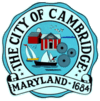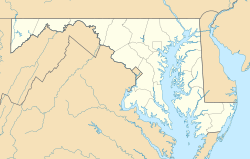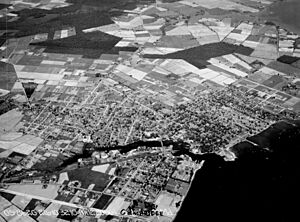Cambridge, Maryland facts for kids
Quick facts for kids
Cambridge, Maryland
|
|||
|---|---|---|---|
|
City
|
|||
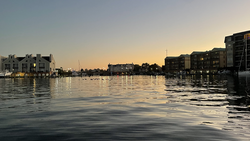
Cambridge Creek at sunset
|
|||
|
|||
| Motto(s):
"Living, Working, Relaxing...And Loving It"
|
|||
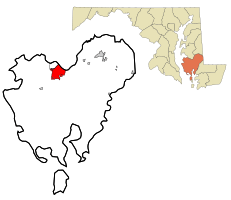
Location in Dorchester County and the State of Maryland
|
|||
| Country | |||
| State | |||
| County | |||
| Incorporated | 1793 | ||
| Area | |||
| • Total | 12.95 sq mi (33.53 km2) | ||
| • Land | 10.65 sq mi (27.58 km2) | ||
| • Water | 2.30 sq mi (5.96 km2) | ||
| Elevation | 20 ft (6 m) | ||
| Population
(2020)
|
|||
| • Total | 13,096 | ||
| • Density | 1,230.02/sq mi (474.90/km2) | ||
| Time zone | UTC−5 (Eastern (EST)) | ||
| • Summer (DST) | UTC−4 (EDT) | ||
| ZIP code |
21613
|
||
| Area code | 410 | ||
| FIPS code | 24-12400 | ||
| GNIS feature ID | 0589879 | ||
Cambridge is a city in Dorchester County, Maryland, United States. It is the main city and county seat of Dorchester County. In 2020, about 13,096 people lived there. Cambridge is the fourth largest city on Maryland's Eastern Shore.
Contents
History of Cambridge
Early Settlement and Growth
Cambridge was settled by English colonists in 1684, making it one of Maryland's oldest colonial cities. At that time, the Choptank Native Americans lived along the river that shares their name. Early English settlers grew crops like tobacco and other foods.
Cambridge became an important trading center. Its town pier was a major spot for the slave trade, which is a sad part of its history. You can find historical markers around town that tell this story.
Becoming a City and New Industries
Cambridge officially became a city in 1793. It was named after a city in England. The town also became a stop on the Underground Railroad, a secret network that helped enslaved people escape to freedom in the North.
In the late 1800s, Cambridge became known for its food processing factories. They canned oysters, tomatoes, and sweet potatoes. The Phillips Packing Company grew to be the biggest employer in the area. They even got contracts from the government during World War I and World War II. At its busiest, the company had about 10,000 workers! But as food tastes changed, the company closed in the 1960s. This caused many people to lose their jobs and led to problems in the city.
Civil Rights Movement in Cambridge
From 1962 to 1967, Cambridge was a key place for the Civil Rights Movement. Black residents protested to get fair jobs, housing, and to end racial segregation in schools and public places. There were some difficult times, including riots in 1963 and 1967. The Maryland National Guard was called in to help keep the peace.
A brave leader named Gloria Richardson led the movement in Cambridge. Thanks to the Civil Rights Act of 1964, public segregation in Cambridge officially ended.
Cambridge Today
In 2002, a large Hyatt Regency Chesapeake Bay resort opened. This brought many jobs and tourists to Cambridge. The resort has a golf course, a spa, and a marina. It has even hosted important events, including visits from U.S. Presidents George W. Bush and Barack Obama.
Cambridge was named a Maryland Main Street community in 2003. This program helps improve downtown areas and attract visitors. Because of this, the historic downtown area of Cambridge has been made much nicer. Many old buildings are now part of a historic district.
Several historic places in Cambridge are listed on the National Register of Historic Places. These include old churches, homes, and other important sites.
Geography and Climate
Cambridge is located on the southern bank of the Choptank River. The city covers about 12.64 square miles (32.74 square kilometers), with most of it being land and a smaller part being water.
Local Climate
Cambridge has a humid subtropical climate. This means it has hot, humid summers and generally mild to cool winters.
Helping the Environment
There's a large solar farm in Cambridge that helps the environment. It produces enough clean energy to power about 40% of the National Aquarium in Baltimore. This helps reduce about 1,300 metric tons of carbon dioxide during the summer!
Population Information
| Historical population | |||
|---|---|---|---|
| Census | Pop. | %± | |
| 1860 | 1,862 | — | |
| 1870 | 1,642 | −11.8% | |
| 1880 | 2,262 | 37.8% | |
| 1890 | 4,192 | 85.3% | |
| 1900 | 5,747 | 37.1% | |
| 1910 | 6,407 | 11.5% | |
| 1920 | 7,467 | 16.5% | |
| 1930 | 8,544 | 14.4% | |
| 1940 | 10,102 | 18.2% | |
| 1950 | 10,351 | 2.5% | |
| 1960 | 12,239 | 18.2% | |
| 1970 | 11,595 | −5.3% | |
| 1980 | 11,703 | 0.9% | |
| 1990 | 11,514 | −1.6% | |
| 2000 | 10,911 | −5.2% | |
| 2010 | 12,326 | 13.0% | |
| 2020 | 13,096 | 6.2% | |
| U.S. Decennial Census 2010 2020 |
|||
How Many People Live Here?
In 2020, the population of Cambridge was 13,096 people. This means the city has grown over the years.
Who Lives in Cambridge?
The table below shows the different groups of people living in Cambridge based on the 2010 and 2020 censuses.
| Race / Ethnicity | Pop 2010 | Pop 2020 | % 2010 | % 2020 |
|---|---|---|---|---|
| White alone (NH) | 5,419 | 5,001 | 43.96% | 38.19% |
| Black or African American alone (NH) | 5,814 | 6,208 | 47.17% | 47.40% |
| Native American or Alaska Native alone (NH) | 33 | 26 | 0.27% | 0.20% |
| Asian alone (NH) | 162 | 192 | 1.31% | 1.47% |
| Pacific Islander alone (NH) | 4 | 2 | 0.03% | 0.02% |
| Some Other Race alone (NH) | 19 | 66 | 0.15% | 0.50% |
| Mixed Race/Multi-Racial (NH) | 265 | 558 | 2.15% | 4.26% |
| Hispanic or Latino (any race) | 610 | 1,043 | 4.95% | 7.96% |
| Total | 12,326 | 13,096 | 100.00% | 100.00% |
Note: The US Census counts Hispanic/Latino as an ethnic group. This table separates them from the racial categories.
In 2010, there were 12,326 people living in Cambridge. The population density was about 1,192 people per square mile. About 47.9% of the people were Black or African American, and 45.9% were White. About 4.9% of the population was Hispanic or Latino.
The average age in the city was 37.6 years. About 24.5% of residents were under 18 years old.
Media and News
Cambridge has several ways to get local news and entertainment.
Radio and TV
Draper Media broadcasts several radio stations from Cambridge, including WCEM (AM), WCEM-FM, WTDK-FM, and WAAI-FM. Their studios also serve as a news office for WBOC-TV, which covers local news for Cambridge and nearby areas every weekday evening.
WHCP-LP 101.5 FM is a community radio station that broadcasts from downtown Cambridge.
Newspapers
Cambridge has two weekly newspapers: the Dorchester Star and the Dorchester Banner. The Dorchester Banner was the first daily newspaper on the Eastern Shore, starting way back in 1897.
Transportation
Getting around Cambridge and to other places is made easy by its transportation options.
Roads
U.S. Route 50 is a very important road that goes right through Cambridge. It's known as "Ocean Gateway" locally, and the part from the Choptank River to the eastern edge of Cambridge is called "Sunburst Highway." This highway stretches all the way from Ocean City, Maryland to Sacramento, California.
Airport
The Cambridge-Dorchester Airport (FAA Identifier: CGE) is a public airport located just outside Cambridge. It's used for general aviation, meaning smaller planes, and has a lighted runway that is 4,477 feet long.
Railroad
The Maryland & Delaware Railroad (MDDE) used to provide freight train service to Cambridge. While the train tracks are still there, service was stopped in 2016.
Horn Point Laboratory
Horn Point Laboratory is a cool place that is home to the biggest oyster hatchery on the East Coast. This means they raise lots of baby oysters here!
There's a fun old story that says in 1699, the famous pirate William Kidd hid treasure he stole from sugar traders on the land where Horn Point Lab is today. Students and researchers at the lab sometimes like to guess where the treasure might be hidden!
Notable People from Cambridge
Many interesting people have connections to Cambridge:
- Beatrice Arthur: A famous actress who starred in TV shows like Maude and The Golden Girls. She grew up in Cambridge.
- John Barth: A well-known writer, born in Cambridge in 1930.
- Stephen Allen Benson: He became the second President of Liberia, a country in Africa.
- Troy Brohawn: A retired Major League Baseball player.
- Willis Conover: Known as the "Voice of America" DJ, he lived in Cambridge in the late 1930s.
- Charles Goldsborough: A former Governor of Maryland and U.S. Congressman.
- Phillips Lee Goldsborough: Another former Governor of Maryland and a U.S. Senator.
- Emerson Columbus Harrington: He also served as a Governor of Maryland.
- Thomas Holliday Hicks: Another former Governor of Maryland.
- Antwan Lake: An NFL defensive end who played for several teams.
- Henry Lloyd: A former Governor of Maryland.
- Annie Oakley: A famous sharpshooter, she lived in Cambridge for a few years.
- Gloria Richardson Dandridge: A very important leader in the Civil Rights Movement in Cambridge.
- Harriet Tubman: A brave escaped slave and a famous conductor on the Underground Railroad.
- Norman Chaney: An actor who played the character "Chubby" in Our Gang (also known as The Little Rascals).
Images for kids
See also
 In Spanish: Cambridge (Maryland) para niños
In Spanish: Cambridge (Maryland) para niños



